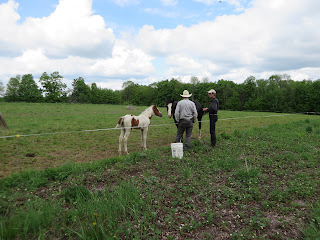Have you received a flyer and or have seen one of our print or on-line advertisements? If you are interested in learning more about buying our produce with a pre-paid subscription, check out the "Join Our CSA" page by clicking on the tab above.
I prefer to speak with new customers before signing them up for a season of vegetable deliveries, to ensure that what I provide matches your needs. These phone conversations typically last about twenty minutes.
Contact me by email or phone and we can go from there...
I have placed a few posters and distributed a limited amount of flyers in the town of Perth to see if there is any interest in that area for deliveries. At this time, I anticipate that the neighborhood bounded by Hwy's 7 and 10, Drummond and Perthmore is the only place I will consider for deliveries.
We have sold 68 per cent of our projected shares - quite slower than most years. I'll take a few more customers in the next week or so, and then close sales for the season.
I had planned on selling all shares when early crops were started in the nursery (peppers, tomatoes) and when I ordered seed potatoes, so there are more of these than I will need to feed the subscription shares. As these are already planted, all shares will be topped up a little, and there will be plenty to sell as extras for those who want to put food by for the winter. Customers who have purchased a share will have first option on these extra purchases.
Extra food will also be sent to the local food banks as well.
I have sourced two pigs for this season. As with any agricultural endeavor, nothing is certain until it is on the plate, but at this point it is certain enough for me to start planning.
More info to follow on the "Pork" page...
Hello Everyone:

The fields are cleaned up and the seeds and transplants are moving in.
Now that the nights are consistently over 10 degrees, the insect netting goes over the garlic and onions to protect these crops from leek moths; and some light row cover goes over the newest transplants to provide some relief from the sun while they transition into their spot of soil.
All the nylon doesn't make the farm look good, but at least it is a sign of progress.
Last week-end, we went up to Ellenberger Organic Farm to pick up our seed potatoes.
I am always awed by these animals. I've only ever seen them work, once, briefly, at another farm.
To me, these animals are the embodiment of power.
Henry also uses tractors, but he finds horses are more pleasant to work with and don't break down as much as old machinery does.
I've always had a bit of trouble getting spinach to germinate successfully, but it would appear the cool weather of the past couple of weeks helped a lot.
Onions do not look very promising for several weeks after transplant. These went into the ground about early May and late April, and don't appear to have done much.
The bulbs will finally start to appear soon after the solstice, when the changing day length stimulates the bulb development.
Another slow grower that takes a lot of time to look like something you would want to eat is celery. Hard to believ at this stage of their life that these will be full sized bunches in about sixty days.
I have noticed a big difference between the beds that were started last year and the beds that were started three years ago. The ground on th e older beds are softer to work and easier to plant in.
Which is a relief to know as I look at the next portion of fields that are freshly plowed and ready for clean up for future growth in the years to come.
By the time the next post is written, there should be a lot more seeds and transplants in the ground, and the celery and maybe the onions will start to look more like you'd expect.
Talk to you soon...









